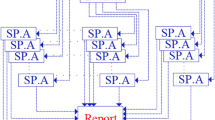Abstract
Load balancing and task partitioning are important components of distributed computing. The optimum performance from the distributed computing system is achieved by using effective scheduling and load balancing strategy. Researchers have well explored CPU, memory, and I/O-intensive tasks scheduling, and load balancing techniques. But one of the main obstacles of the load balancing technique leads to the ignorance of applications having a mixed nature of tasks. This is because load balancing strategies developed for one kind of job nature are not effective for the other kind of job nature. We have proposed a load balancing scheme in this paper, which is known as Mixed Task Load Balancing (MTLB) for Cluster of Workstation (CW) systems. In our proposed MTLB strategy, pre-tasks are assigned to each worker by the master to eliminate the worker’s idle time. A main feature of MTLB strategy is to eradicate the inevitable selection of workers. Furthermore, the proposed MTLB strategy employs Three Resources Consideration (TRC) for load balancing (CPU, Memory, and I/O). The proposed MTLB strategy has removed the overheads of previously proposed strategies. The measured results show that MTLB strategy has a significant improvement in performance.
Similar content being viewed by others
References
Lee L-W, Scheuermann P, Vingralek R (2000) File assignment in parallel i/o systems with minimal variance of service time. IEEE Trans Comput 49:127–140
Arpaci-dusseau RH, Anderson E, Treuhaft N, Culler DE, Hellerstein JM, Patterson D, Yelick K (1999) Cluster i/o with river: making the fast case common. In: Proceedings of the sixth workshop on input/output in parallel and distributed systems. ACM, New York, pp 10–22
Arabnia HR, Smith JW (1993) A reconfigurable interconnection network for imaging operations and its implementation using a multi-stage switching box. In: Proceedings of the 7th annual international high performance computing conference. The 1993 high performance computing: new horizons supercomputing symposium, Calgary, Alberta, Canada, June, pp 349–357
Cap CH, Strumpen V (1993) Efficient parallel computing in distributed workstation environments. Parallel Comput 19(11):1221–1234
Harchol-Balter M, Downey AB (1997) Exploiting process lifetime distributions for dynamic load balancing. ACM Trans Comput Syst 15(3):253–285
Qureshi K, Shah SMH, Manuel P (2010) Empirical performance evaluation of schedulers for cluster of workstations, Int J Clust Comput, doi:10.1007/s10586-010-0128-5
Qureshi K, Hussain SS (2008) A comparative study of parallelization strategies for fractal image compression on a cluster of workstations. Int J Comput Methods 5(3):463–482
Qin X (2008) Performance comparisons of load balancing algorithms for i/o-intensive workloads on clusters. J Netw Comput Appl 31(1):32–46
Shah SMH, Qureshi K, Rasheed H (2009) Optimal job packing, a backfill scheduling optimizations for cluster of workstations. J Supercomput, doi:1007/S11227-009-0332-3
Green T, Duke D, Pasko J (1994) Research toward a heterogeneous networked computing cluster: The distributed queuing system version 3.0, Florida State University
Zhou S, Zheng X, Wang J, Delisle P (1993) Utopia: a load sharing facility for large, heterogeneous distributed computer systems. Tech. report
Ma X, Winslett M, Lee J, Yu S (2002) Faster collective output through active bu_ering. In: IPDPS ’02: Proceedings of the 16th international parallel and distributed processing symposium. IEEE Computer Society, Washington, p 151
Cho Y, Winslett M, Subramaniam M, Chen Y, Kuo S, Seamons KE (1997) Exploiting local data in parallel array i/o on a practical network of workstations. In: IOPADS ’97: Proceedings of the fifth workshop on I/O in parallel and distributed systems. ACM, New York, pp 1–13
Zhang Y, Yang A, Sivasubramaniam A, Moreira J (2003) Gang scheduling extensions for i/o intensive workloads. In: proceedings of the job scheduling strategies for parallel processing workshop
Qin X, Jiang H, Zhu Y, Swanson DR (2003) Dynamic load balancing for i/o- and memory-intensive workload in clusters using a feedback control mechanism. Euro-Par, pp. 224–229
Author information
Authors and Affiliations
Corresponding author
Rights and permissions
About this article
Cite this article
Qureshi, K., Majeed, B., Kazmi, J.H. et al. Task partitioning, scheduling and load balancing strategy for mixed nature of tasks. J Supercomput 59, 1348–1359 (2012). https://doi.org/10.1007/s11227-010-0539-3
Published:
Issue Date:
DOI: https://doi.org/10.1007/s11227-010-0539-3




